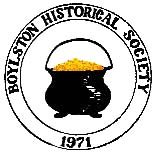A Blue Star Flag
A Blue Star Flag
By Inga Milbauer
This year marked the 75th anniversary of the end of World War II.
On August 26, 1943 the residents of Boylston gathered in front of the library to dedicate an Honor Roll bearing the names of ninety service men and women. One of these men was John White Fellows, who served as 1st Lt. in the U.S. Marine Corps. His wife, Clara Kelley Fellows, donated this Service flag to the Boylston Historical Museum.
U.S. Army Captain Robert L. Queisser of the 5th Ohio Infantry, who had two sons serving on the front line, designed and patented the Service flag in 1917. The Service flag, also known as the Blue Star Flag, became an unofficial symbol of having a child serving in the army during WWI. In 1918, President Wilson approved the suggestion made by the Women’s Committee of the Counsel of National Defenses that mothers who had lost a child serving in the war wear a gold gilt star on the traditional black mourning arm band. This led to the tradition of covering the blue star on the Service flag with a gold star to indicate that the service member was killed in action or died in service.
The practice of displaying the Service Flag became more widespread during WWII. One of the most memorable Service flags was that of the five Sullivan brothers who all perished on the U.S.S. Juneau on November 13th, 1942. In 1966, the Department of Defense revised the specification for the design, manufacture and display of the Service flag. “The Service flag is an official banner authorized by the Department of Defense for display by families who have members serving in the Armed Forces during any period of war or hostilities the United States may be engaged in for the duration of such hostilities.” The flag may also be displayed by an organization to honor the members of that organization serving. The Service flag should be displayed indoors, facing out from the window of the home or organization.
By the end of World War II, 156 Boylstonians had served. Sadly, three men lost their lives: George L. Button (died of wounds on Peleliu Island, November 17, 1944), John Barton (killed in action in Germany, March 1945), and William H. Brown (killed in action in Italy, April 17, 1945). Boylston prepared a ‘welcome home’ celebration for the returning WWII veterans on July 5th and 6th, 1946. The festivities were organized by the Boylston Police Association and began Friday evening with a ball at the Town House. On Saturday, services were held at St. Mary’s of the Hills and the Congregational Churches, followed by a parade, sports activities on the Common, and a concert by the Worcester Brass Band. Massachusetts Governor Maurice Tobin was guest speaker at the thanksgiving ceremony, in the evening a banquet was held at the Town House, outdoor movies were shown, and the day concluded with a fireworks display.
Veterans Day will be upon us next week, a day to pay tribute to all veterans who are serving and have served in the United States Armed Forces – with special appreciation for our Boylston veterans!
Acknowledgements: bluestarmothers.org, Boylston Historical Series Vol. XIII by William O. Dupuis; nationalww2museum.org; Editing & photography by Nancy Filgate; wikipedia.com
